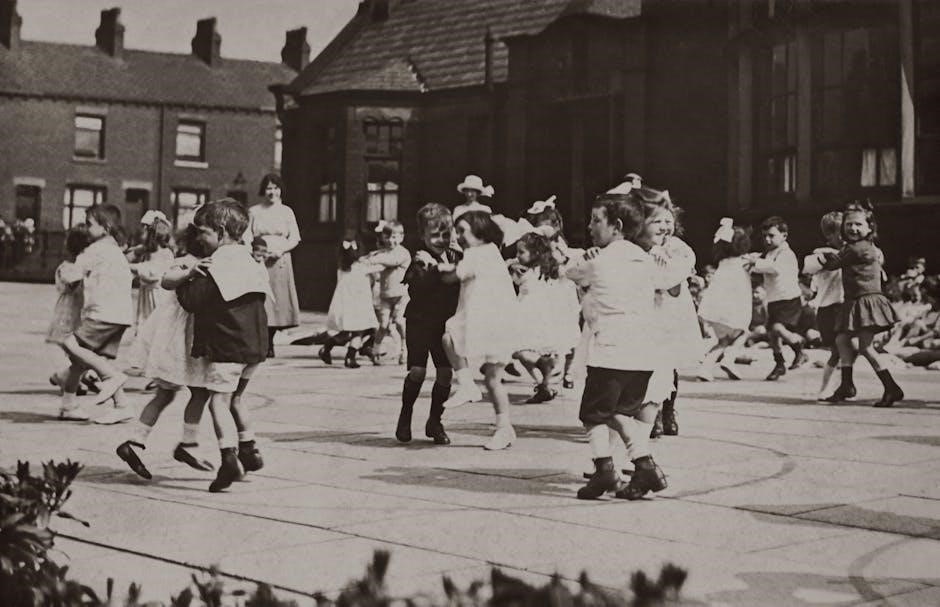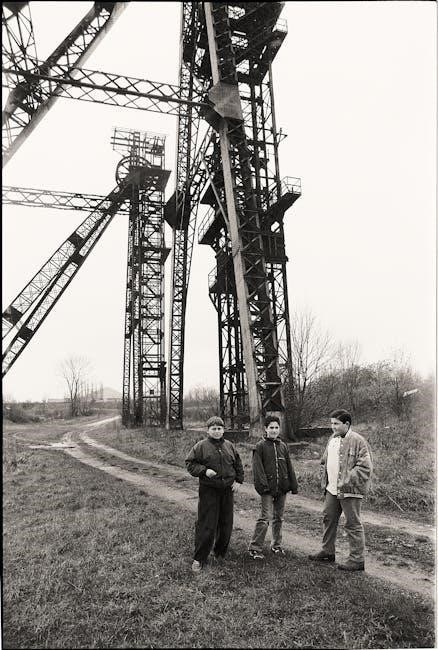Edith Wharton’s The Age of Innocence is a timeless novel set in New York’s Gilded Age, exploring themes of love, societal expectations, and personal sacrifice․ Published in 1920, it won the Pulitzer Prize in 1921, becoming a classic of American literature․ The story follows Newland Archer, a man torn between his duty to his fiancée and his passion for her cousin, Ellen Olenska, a woman who challenges the conventions of their rigid society․ The novel is celebrated for its nuanced portrayal of human emotions and the constraints of social class, offering a profound commentary on the tension between individual desire and societal norms․
About the Author: Edith Wharton
Edith Wharton, a renowned American novelist, published The Age of Innocence in 1920, earning the 1921 Pulitzer Prize for Fiction․ Her work masterfully explores social dynamics, human emotions, and societal constraints, leaving a lasting literary legacy․
2․1 Background and Contributions
Edith Wharton, born in 1862, was a prominent American novelist and short story writer known for her insightful portrayals of the social elite․ Raised in a wealthy family, Wharton drew heavily from her experiences of the Gilded Age, crafting narratives that explored themes of love, morality, and societal constraints․ Her work often criticized the rigid social structures of her time, earning her both acclaim and controversy․ Wharton’s writing style was marked by precision, irony, and a deep understanding of human psychology․ The Age of Innocence stands as one of her most celebrated works, winning the Pulitzer Prize in 1921 and solidifying her place in American literary history․ Her contributions to literature continue to resonate, offering timeless reflections on the human condition and the enduring struggle between individual desire and societal expectations․
2․2 Inspiration Behind “The Age of Innocence”
Edith Wharton drew inspiration for The Age of Innocence from her own experiences within the rigid social hierarchy of New York’s Gilded Age․ The novel reflects her keen observation of the era’s societal norms, where individual desires were often stifled by the expectations of family and class․ Wharton’s personal life, including her marriage and friendships, influenced her portrayal of Newland Archer’s internal conflict․ The character of Ellen Olenska was inspired by women Wharton encountered who challenged conventional roles, offering a glimpse of the freedom and independence that society denied them․ Wharton’s deep understanding of human emotions and her ability to critique the hypocrisy of her time transformed these inspirations into a timeless exploration of love, duty, and personal sacrifice․ The novel remains a powerful commentary on the tension between individual aspirations and the constraints of a traditionalist society․

Plot Summary
The Age of Innocence is set in 1870s New York and follows the story of Newland Archer, a young lawyer engaged to May Welland, a woman from a respected family․ Their seemingly perfect union is disrupted by the arrival of May’s cousin, Ellen Olenska, who returns to New York after leaving her unfaithful husband in Europe․ Ellen’s independence and unconventional behavior challenge the rigid social norms of the time, captivating Newland and creating a deep emotional connection between them․ Torn between his duty to May and his growing love for Ellen, Newland struggles with the constraints of his society․ The novel explores the tension between personal desire and societal expectations, culminating in a poignant conclusion that highlights the sacrifices individuals make to uphold tradition․ Through its intricate characters and nuanced storytelling, The Age of Innocence offers a compelling critique of the Gilded Age’s social conventions․

Major Themes
The novel explores themes of social class and wealth, highlighting the rigid conventions of New York’s Gilded Age society․ It also delves into the conflict between love and duty, as characters navigate personal desires versus societal expectations․ The tension between individual freedom and the constraints of tradition is a central focus, reflecting the era’s moral and cultural norms․
4․1 Social Class and Wealth
In The Age of Innocence, social class and wealth are central themes, vividly portraying the rigid stratification of New York’s Gilded Age elite․ The novel highlights how the upper class maintained its power through strict conventions, with individuals often prioritizing societal expectations over personal desires․ Wealth was not only a measure of status but also a tool to enforce conformity, as seen in the elaborate social rituals and marriages arranged for economic or familial advantage․ Edith Wharton critiques this system, revealing its emptiness and hypocrisy, particularly through characters like Newland Archer, who struggles with the confines of his privileged world; The contrast between the opulent lifestyles of the wealthy and the limited opportunities for those outside their circle underscores the era’s social inequality․ Wharton’s portrayal of this world is both nuanced and incisive, offering a timeless commentary on the interplay of class, wealth, and personal identity․
4․2 Love vs․ Duty
The tension between love and duty is a central conflict in The Age of Innocence, as Newland Archer grapples with his passion for Ellen Olenska and his obligation to marry May Welland․ The novel portrays a society where duty to family, social norms, and tradition often supersedes personal desire․ Newland’s internal struggle reflects the moral and emotional paralysis of a man caught between two worlds: the conventional life he is expected to lead and the unconventional love he truly longs for․ Wharton masterfully explores this conflict, highlighting the sacrifices individuals make to uphold societal expectations․ The novel ultimately presents a tragic view of love, where duty triumphs over passion, leaving the characters to live with the consequences of their choices․ This theme resonates deeply, offering a poignant critique of the constraints placed on individual freedom by societal norms․ The clash of love and duty remains one of the novel’s most enduring and universal themes․

Key Characters
The novel revolves around a cast of complex characters, each embodying the societal norms and personal struggles of the Gilded Age․ Newland Archer, the protagonist, is a man torn between his duty to society and his passion for Ellen Olenska․ May Welland, Newland’s fiancée, represents the epitome of innocence and tradition, while Ellen Olenska, May’s cousin, is a free-spirited woman who challenges the conventions of their rigid society․ Mrs․ Manson Mingott, the matriarch of the Mingott family, wields significant influence over the social circle, reflecting the power dynamics of the wealthy elite․ Mr․ Archer and Mrs․ Archer, Newland’s parents, symbolize the traditional values that govern their world․ Together, these characters navigate a web of social expectations, love, and duty, creating a rich tapestry of human emotion and societal critique․ Their interactions drive the novel’s exploration of personal sacrifice and the constraints of a rigid social hierarchy․

Historical Context: The Gilded Age
The Age of Innocence is set against the backdrop of the Gilded Age, a period of rapid industrialization and social change in late 19th-century America․ This era, characterized by vast wealth inequality and rigid social hierarchies, provides the novel’s rich historical context․ The Gilded Age was marked by the rise of old-money families and the emergence of nouveau riche, creating a complex web of social rules and expectations․ Wharton’s New York is a society governed by unwritten codes of conduct, where reputation and family standing are paramount․ The novel critiques the hypocrisy and superficiality of this elite class, while also highlighting their struggle to adapt to modernity․ The Gilded Age’s tension between tradition and progress serves as the perfect setting for Newland Archer’s internal conflict, as he grapples with love, duty, and the constraints of his world․ Wharton’s meticulous portrayal of this era underscores the universal themes of societal pressure and personal freedom․
The Novel’s Awards and Recognition
The Age of Innocence is widely acclaimed and has received significant literary recognition․ In 1921, it won the Pulitzer Prize for Fiction, marking a milestone in Edith Wharton’s career․ This prestigious award not only highlighted the novel’s artistic merit but also cemented its place in American literary history․ The book’s nuanced exploration of societal norms and human emotions resonated with critics and readers alike․ Its success led to numerous editions and adaptations, further solidifying its reputation as a classic․ The novel’s enduring popularity is evident in its availability in multiple formats, including free PDF downloads, ensuring its accessibility to a global audience․ Wharton’s masterpiece continues to be celebrated for its timeless themes and masterful storytelling, making it a must-read for literature enthusiasts and scholars alike․ Its recognition extends beyond awards, as it remains a foundational text in studies of the Gilded Age and American society․

Importance of the PDF Format
The PDF format has become a popular choice for reading The Age of Innocence due to its convenience and accessibility․ As a digital format, PDF preserves the original layout and formatting of the novel, ensuring an authentic reading experience․ It is also widely compatible with various devices, including smartphones, tablets, and e-readers, making it easy to access the book anywhere․ Additionally, PDF files are often available for free, especially for classic works like The Age of Innocence, which is in the public domain․ This accessibility has democratized literature, allowing readers worldwide to enjoy Wharton’s masterpiece without cost․ Furthermore, PDFs are ideal for academic and educational purposes, as they can be easily shared and referenced․ The availability of The Age of Innocence in PDF format has played a significant role in preserving its literary legacy and introducing it to new generations of readers․
The Novel’s Style and Structure
Edith Wharton’s The Age of Innocence is renowned for its meticulous prose and structured narrative, which masterfully captures the essence of New York’s Gilded Age society․ Wharton employs a third-person omniscient perspective, allowing readers to delve into the innermost thoughts and emotions of the characters, particularly Newland Archer․ The novel’s style is characterized by its precision and evocative descriptions, which paint a vivid picture of the era’s social norms, customs, and material grandeur․ The structure is linear, with each chapter progressing chronologically, building tension as Archer grapples with his conflicting desires․ Wharton’s use of irony and subtlety underscores the societal constraints that govern her characters’ lives, creating a tragic yet thought-provoking narrative․ Her writing is both elegant and profound, offering a timeless exploration of human emotions and the rigid conventions of the past․ This blend of style and structure ensures the novel remains a compelling and insightful read․
Adaptations and Interpretations
The Age of Innocence has inspired numerous adaptations across various media, reflecting its enduring appeal․ The most notable adaptation is Martin Scorsese’s 1993 film starring Daniel Day-Lewis, Michelle Pfeiffer, and Winona Ryder, which won the Academy Award for Best Costume Design․ This adaptation remains faithful to the novel, capturing the intricate dynamics of the characters and the oppressive elegance of the Gilded Age․ Additionally, the novel has been adapted into stage plays, operas, and radio dramas, each offering unique interpretations of Wharton’s work․ These adaptations highlight the timeless themes of love, duty, and societal constraints, resonating with audiences across generations․ The novel’s rich narrative and complex characters provide ample material for creative reinterpretation, ensuring its continued relevance in modern media․ Through these adaptations, The Age of Innocence continues to engage new audiences, solidifying its place as a classic in both literature and film․
Critical Reception
The Age of Innocence has received widespread critical acclaim for its profound exploration of societal norms and human emotions․ Critics have praised Edith Wharton’s nuanced portrayal of the Gilded Age, highlighting her sharp wit and insightful commentary on the rigid social conventions of the time․ The novel’s ability to balance historical detail with psychological depth has been particularly lauded․ Many reviewers have noted Wharton’s unique prose style, which blends elegance with a piercing critique of the era’s hypocrisies․ The character development, especially the tragic plight of Newland Archer, has been celebrated for its complexity and emotional resonance․ The novel’s timeless themes of love, duty, and individual freedom have made it a cornerstone of American literature․ Its Pulitzer Prize win in 1921 further solidified its reputation as a masterpiece․ Overall, The Age of Innocence is regarded as a brilliant critique of societal expectations and a deeply moving exploration of the human condition․

Where to Download the PDF
The PDF version of The Age of Innocence is widely available for free download from various reputable sources․ Platforms like Project Gutenberg and LitRes offer the novel in multiple formats, including PDF, EPUB, and Kindle․ These sites provide easy access without requiring registration, making it convenient for readers to download and enjoy the book․ Additionally, platforms such as Archive․org host digital copies of the novel, ensuring its availability for future generations․ Many of these sites are non-profit and dedicated to preserving classic literature, allowing readers to download The Age of Innocence at no cost․ For those seeking a hassle-free experience, these platforms are ideal for accessing Edith Wharton’s timeless masterpiece in a format suitable for any device․

Why It’s a Must-Read
The Age of Innocence is a must-read for its timeless exploration of universal themes such as love, duty, and societal expectations․ Edith Wharton’s masterful prose and nuanced characterization bring to life the intricate social dynamics of New York’s Gilded Age, offering a profound commentary on human emotions constrained by rigid conventions․ The novel’s central conflict between personal desire and societal obligations resonates deeply with readers across generations․ Its Pulitzer Prize-winning status underscores its literary significance and enduring appeal․ For both casual readers and scholars, Wharton’s work provides a rich tapestry of themes and insights into the human condition․ Additionally, its availability in formats like PDF makes it easily accessible, ensuring that this classic remains relevant and reachable for modern audiences seeking a compelling and thought-provoking read․

Educational and Academic Use
The Age of Innocence is widely used in educational settings due to its rich thematic depth and historical significance․ The novel provides a compelling exploration of the Gilded Age, making it a valuable resource for studying American history, literature, and culture․ Its themes of social class, love, and duty offer fertile ground for critical analysis, encouraging students to engage with complex moral and ethical dilemmas․ The text is often included in high school and university curricula to teach literary analysis, character development, and historical context․ Additionally, the availability of the novel in PDF format ensures easy access for students and educators, facilitating its use in classrooms and research․ The novel’s timeless relevance and Wharton’s masterful prose make it an essential text for fostering critical thinking and understanding of early 20th-century American society․

Modern Relevance
Despite being written over a century ago, The Age of Innocence remains strikingly relevant in modern times․ Its exploration of universal themes such as love, societal expectations, and individual freedom continues to resonate with contemporary audiences․ The novel’s portrayal of the tension between personal desire and societal norms speaks to ongoing conversations about identity, morality, and the constraints of culture․ Additionally, its commentary on gender roles and class structures offers a lens through which to examine modern inequalities and the ongoing fight for social justice․ The availability of the novel in PDF and other digital formats ensures that its timeless messages are easily accessible to new generations of readers․ As society continues to evolve, The Age of Innocence serves as a powerful reminder of the enduring human struggle to balance tradition with progress and duty with passion․
The Age of Innocence by Edith Wharton is a masterful exploration of love, duty, and societal expectations, set against the backdrop of New York’s Gilded Age․ Through its nuanced characters and rich thematic depth, the novel offers a profound commentary on the human condition, making it a timeless classic․ Its availability in PDF and other digital formats ensures that this Pulitzer Prize-winning work remains accessible to modern readers․ The novel’s themes of personal sacrifice and the constraints of social class continue to resonate, providing insights into both the past and the present․ The Age of Innocence is not only a historical gem but also a deeply relatable story that invites readers to reflect on their own values and choices․ Its enduring relevance underscores the power of literature to transcend time and connect with readers across generations․
FAQs
- Where can I download “The Age of Innocence” in PDF? The novel is available for free download in PDF, epub, and Kindle formats from platforms like Project Gutenberg, Litres, and Archive․org․
- Is the PDF version free? Yes, the book is in the public domain, so you can download it for free without any registration or payment․
- What devices can I read the PDF on? The PDF can be read on computers, tablets, e-readers, and smartphones with PDF-viewing apps․
- Why is “The Age of Innocence” considered a must-read? It explores timeless themes like love, duty, and societal expectations, making it a significant work of American literature․
- What is the main plot of the novel? It follows Newland Archer, a man torn between his engagement to May Welland and his growing feelings for her cousin, Ellen Olenska․
